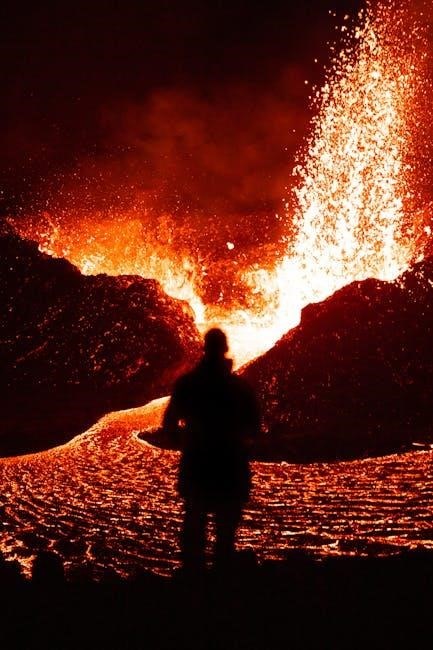Guiding Hazard involves identifying and managing risks to ensure safety and minimize potential threats. It focuses on proactive strategies to prevent incidents and protect people, assets, and environments effectively.
This approach is essential for creating secure systems and fostering resilience in various industries.

Definition and Scope
Guiding Hazard refers to a systematic process of identifying, assessing, and mitigating risks to ensure safety. It encompasses strategies to prevent incidents and protect people, assets, and environments across various industries.
Its scope includes regulatory compliance, risk management, and proactive safety measures to minimize potential threats.
2.1. What is Hazard Guidance?
Hazard guidance refers to the process of identifying, evaluating, and communicating potential risks to ensure safety and minimize harm. It involves systematic approaches to recognize hazards, assess their severity, and implement controls to mitigate them.
Hazard guidance is essential in various industries, including construction, healthcare, and manufacturing, where risks are inherent. It provides a framework for proactive risk management, ensuring compliance with safety standards and regulations.
By understanding hazards and their potential impacts, organizations can develop strategies to prevent incidents, protect employees, and maintain operational integrity. Effective hazard guidance fosters a culture of safety and accountability.
2.2. Key Concepts in Hazard Management
Hazard management encompasses several critical concepts, including risk assessment, hazard identification, and control measures. Risk assessment involves evaluating the likelihood and impact of hazards to prioritize mitigation efforts.
Key concepts also include the hierarchy of controls, which emphasizes eliminating hazards at the source. Administrative controls, such as training and procedures, and engineering controls, like safety equipment, are integral to this hierarchy.
Monitoring and continuous improvement are essential to ensure the effectiveness of hazard management systems. Regular audits and feedback loops help organizations adapt to changing conditions and refine their strategies.
Understanding these concepts is vital for creating a robust hazard management plan that protects people, assets, and the environment from potential threats.
Types of Hazards
Hazards can be broadly categorized into natural, occupational, environmental, and technological types. Natural hazards include earthquakes, floods, and storms, which are unpredictable and pose significant risks to communities. Occupational hazards refer to risks within workplaces, such as exposure to harmful chemicals or machinery-related accidents.
Environmental hazards involve pollution, climate change, and contamination of air, water, or soil, impacting ecosystems and human health. Technological hazards stem from failures in infrastructure or systems, such as cyberattacks or industrial accidents.
Each type of hazard requires distinct strategies for identification and mitigation. Understanding these categories is crucial for developing effective safety protocols and emergency response plans.
Assessing and Identifying Risks
Risk assessment is a critical step in hazard management, involving the identification and evaluation of potential threats. It begins with recognizing hazards and understanding their likelihood and impact. Techniques such as risk matrices and SWOT analyses are commonly used to prioritize risks based on severity and probability.
Key factors include the nature of the hazard, exposure levels, and existing controls. For instance, in occupational settings, workplace inspections and incident reports help identify risks. Environmental risks may involve assessing pollution levels or climate vulnerabilities. Technological risks often require analyzing system failures or cybersecurity threats.
Accurate risk identification ensures that resources are allocated effectively to mitigate dangers. Continuous monitoring and reassessment are essential to adapt to changing conditions and ensure long-term safety. This process forms the foundation for developing robust management strategies.
Effective risk assessment is vital for safeguarding lives, assets, and environments from potential harm.
Management Strategies
Effective hazard management relies on well-structured strategies to control and mitigate risks. These strategies often involve a combination of preventive measures, corrective actions, and ongoing monitoring. The Hierarchy of Controls is a widely used framework, prioritizing elimination, substitution, engineering controls, and personal protective equipment (PPE) to minimize exposure.
Proactive approaches include regular inspections, maintenance programs, and employee training to enhance awareness and compliance. Emergency preparedness plans are also critical, ensuring rapid responses to incidents. Technology plays a key role, with systems like sensors and alarms providing real-time alerts to potential hazards.
Continuous improvement is essential, with organizations reviewing and updating their strategies based on new data or changing conditions. Collaboration between stakeholders, including employees, regulators, and experts, ensures comprehensive and adaptive management systems. By implementing robust strategies, organizations can reduce risks, protect assets, and foster a culture of safety.
Strong management strategies are the cornerstone of effective hazard control and long-term operational resilience.

Real-World Applications
Hazard guidance is applied across various industries to ensure safety and efficiency. For example, in aviation, hazard management systems are used to identify and mitigate risks during flights, such as weather conditions or mechanical failures.
In healthcare, hazard guidance helps in infection control and patient safety, ensuring protocols are followed to prevent accidents and errors. The energy sector utilizes hazard management to safeguard operations in high-risk environments, such as oil rigs or nuclear plants.
Emergency services rely on hazard guidance to respond effectively to incidents like fires or natural disasters. Additionally, industries like construction and manufacturing use these strategies to protect workers and equipment from potential dangers.
By implementing hazard guidance, organizations can reduce risks, enhance operational efficiency, and ensure compliance with safety standards. Real-world applications demonstrate its critical role in saving lives and preventing losses across diverse sectors.
Hazard guidance is indispensable for creating safer and more resilient environments in countless industries.
The Role of Technology
Technology plays a pivotal role in guiding hazard management by enhancing the ability to identify, assess, and mitigate risks. Advanced systems like predictive analytics and IoT sensors enable real-time monitoring of potential hazards, allowing for timely interventions.
Artificial intelligence (AI) and machine learning algorithms analyze historical data to predict risk scenarios, improving decision-making. Additionally, software solutions like incident management systems streamline hazard reporting and response processes, ensuring better coordination.
Technological tools also facilitate training and compliance, providing simulations and guidelines to prepare teams for hazard scenarios. Overall, technology empowers organizations to manage hazards more effectively, reducing risks and enhancing safety.
Modern technology is a cornerstone of efficient and proactive hazard management strategies.
Legal and Regulatory Considerations
Legal and regulatory considerations are critical in guiding hazard management, as they ensure compliance with established standards and protect individuals and organizations from potential liabilities. Governments and regulatory bodies impose specific requirements to mitigate risks and safeguard public health and safety.
Organizations must adhere to laws and regulations related to hazard identification, risk assessment, and control measures. Failure to comply can result in legal penalties, fines, and reputational damage. Key areas of compliance include environmental protection, workplace safety, and emergency response planning.
Regulatory frameworks often require documentation of hazard management processes, including risk assessments, incident reports, and training records. Staying informed about updates to laws and regulations is essential to maintain compliance and avoid legal repercussions.
Understanding and adhering to legal and regulatory standards is a fundamental aspect of effective hazard management.

Best Practices
Implementing best practices in guiding hazard management ensures effective risk mitigation and promotes a culture of safety. Start with thorough risk assessments to identify potential hazards and prioritize actionable steps for control.
Regular training and awareness programs for employees are essential to foster a proactive approach to hazard management. Encourage open communication to report incidents and near misses, enabling continuous improvement of safety protocols.
Adopt a proactive maintenance schedule to address potential hazards before they escalate. Utilize technology, such as monitoring systems, to enhance early detection and response capabilities.
Maintain detailed documentation of hazard management processes, including assessments, corrective actions, and training records. This ensures accountability and provides a reference for future decision-making.
Lastly, stay updated on industry standards and best practices to adapt strategies as needed. Collaborating with experts and peers can further enhance the effectiveness of hazard management efforts.
By following these best practices, organizations can create a safer, more resilient environment for everyone involved.
The integration of risk assessments, management practices, and technological solutions plays a vital role in achieving these goals. Regular training, compliance with regulations, and continuous improvement are essential for sustaining a robust hazard management system.
As industries evolve, adapting to new challenges and advancements in technology will remain key to effective hazard guidance. By fostering a culture of safety and preparedness, organizations can protect their assets, people, and environments from potential hazards.
Ultimately, guiding hazard is not just a regulatory requirement but a proactive approach to preventing incidents and ensuring long-term success. Its principles promote resilience, reduce risks, and contribute to the well-being of all stakeholders involved.
Embracing these practices ensures a safer and more sustainable future for industries and communities alike.
